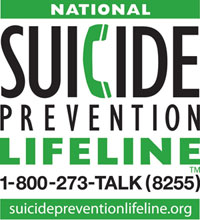Catamounts for the Cause: Suicide Awareness and Prevention
“Suicide is the third leading cause of death among young people.” -Center of Disease Control and Prevention

If you have suicidal thoughts or emotional distress, call this number to be directed to the closest crisis center to your location. Picture Source: National Suicide Prevention Lifeline
Students Against Destructive Decisions
Suicide is the third leading cause of death among young people according to the Center of Disease Control and Prevention. In an effort to confront this matter, Panther Creek has many options available for students who need to seek help. These support systems include counselors, peers, and even a student organized club known as Students Against Destructive Decisions, or SADD.
SADD is a good club for anyone who wants to find other people struggling with the same problems as them, or as a place to help raise awareness. Senior Mariam Marand, the club’s president, told us about the club, “The club’s purpose is to spread awareness about preventing destructive decisions, inspire people to make good decisions, and inform them on the consequences of poor decisions.”
Senior Billy Do, the vice-president of the club, told us about some issues discussed in SADD: “We talk about issues such as drug abuse, suicide, eating disorders, drinking while driving, bullying, and more. We also try to come up with unique ways to bring awareness. For example, last year everyone stuck sticky notes with positive messages on bathroom mirrors so that we could make feel people feel better about themselves.” Billy also told us that the club works on spreading suicide awareness and makes sure that the issue is taken very seriously. The club focuses on making it known to anyone who is having suicidal thoughts that there is at least someone he or she can talk to, as well as resources available to help. If you are interested in this club, check the scrolling announcements on the TV in your classrooms to find out when the next meeting will be. New members are always welcome.
Suicide Awareness
Panther Creek’s Student Assistant Manager (SAP), Mr. Dunaway, told us about what Panther Creek does to raise suicide awareness. Part of the healthful living curriculum requires all freshmen to go through a suicide awareness course during their health class. During this course, students learn about the warning signs and how to act if they, or someone they might know, is having thoughts of self-harm or suicide. The students are then given a piece of paper asking if they want to talk to a counselor about any issues, especially self-harm and suicidal thoughts, and will be in contact with a counselor within twenty-four hours. Everything will be kept confidential between the counselor and the student unless the student is going to harm themselves, harm someone else, or if someone is harming them. Those matters would possibly have to be discussed with parents and guardians.
According to the American Foundation for Suicide Prevention, 50% to 75% of all people who attempt suicide tell someone about their intention. If you or one of your friends is self-harming or having suicidal thoughts, the best thing to do is to get help. If you don’t know where to start, tell a trusted adult or go to Panther Creek’s student services. This website can provide help to anyone currently struggling with depression, self-harm, or suicidal thoughts.
In the case of an emergency, call the National Suicide Prevention Lifeline at 1-800-273-TALK (8255) or 911. The National Suicide Prevention Lifeline is a twenty-four hour crisis hotline that anyone can call for free when having suicidal thoughts or emotional distress. When a person calls this number, they will be put through to the closest crisis center near them. The person will be helped by a trained crisis worker who will talk through the problems the person is currently facing and talk about mental health services in the person’s area.
Warning Signs:
-
A person talking about wanting to kill himself or herself, or saying they wish they were dead.
-
A person looking for a way to kill himself or herself, such as having excessive amounts of medicine/drugs or weapons.
-
A person talking about a specific suicide plan.
-
Someone feeling hopeless or feeling that they have no reason to live.
-
Someone feeling trapped, desperate, or needing to escape from an unbearable situation.
-
A person having the feeling of being a burden to others.
-
Someone feeling humiliated.
-
A person having intense anxiety and/or panic attacks.
-
A person who is losing interest in things, or losing the ability to experience pleasure.
-
Someone experiencing insomnia.
-
A person becoming socially isolated and withdrawn from friends, family, and others.
-
A person acting irritable or agitated.
-
A person who is showing rage, or talking about seeking revenge for being victimized or rejected, even if the situations the person describes seems realistic or not.
Source: American Foundation for Suicide Awareness
To get more information and watch a video on the signs and warnings of someone who could possibly be suicidal, go to this simple and easy to navigate website: Know the Signs
If you think someone you know is contemplating suicide:
1. Make it known that you are concerned to the person.
2. Explain what the person has said or done to make you concerned for them.
3. Ask if the person has considered suicide.
4. Ask if they are already seeking help.
5. Reassure the person that they are not alone.
6. Encourage professional help.
-
If necessary, help the person make an appointment with a professional. At Panther Creek, there are special staff members who deal with students that show self-harm and suicidal behavior that are available to everyone. To set up an appointment, a person could go to student services.
7. If you feel that the person is endanger at any moment, do not leave them alone.
-
Remove any object that could be used for suicide such as firearms, drugs, or sharp objects away from the person.
-
Then take them to a walk-in clinic at psychiatric hospital or a hospital emergency room.
8. Continue to support the person after treatment, for they may still need your help. They might need help and encouragement with finding a psychiatrist that is right for them.
Source: American Foundation for Suicide Prevention
Suicide is never the answer, but getting help is the answer. Contact any of the people mentioned in this article to get help for you or someone you know.




